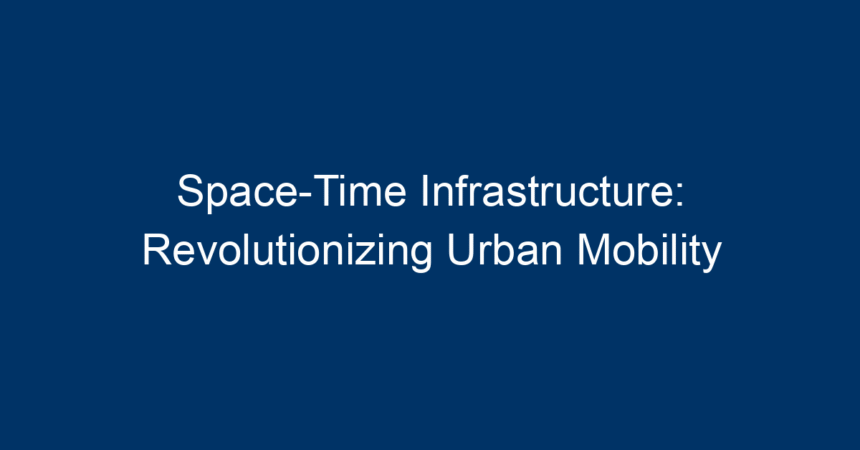In today’s fast-paced urban landscape, the quest for efficient, sustainable, and innovative transportation solutions has never been more critical. Enter the concept of space-time infrastructure, an avant-garde approach that redefines how we navigate our cities. While traditional urban mobility strategies often focus solely on the physical aspects of transport, space-time infrastructure encompasses both space and time dimensions to optimize the flow of people and goods. This article delves deep into what space-time infrastructure entails, its potential to revolutionize urban mobility, and actionable insights for cities looking to implement these transformative ideas.
Understanding Space-Time Infrastructure
What is Space-Time Infrastructure?
Space-time infrastructure refers to a synergistic network of systems and technologies designed to enhance mobility by considering both spatial and temporal factors. Rather than strictly addressing infrastructure in terms of physical routes—like roads, railways, and bike lanes—this approach incorporates advanced technologies, data analytics, and real-time information to create a fluid urban environment.
The Essence of Urban Mobility
Urban mobility is the movement of people and goods within metropolitan areas. It involves a complex interplay of various transportation modes, from private vehicles and public transit to cycling and walking. The current urban mobility landscape faces significant challenges, including traffic congestion, pollution, and unequal access to transportation options. Space-time infrastructure promises to address these issues by optimizing the use of existing resources and introducing smart technologies.
The Components of Space-Time Infrastructure
Intelligent Transportation Systems (ITS)
At the core of space-time infrastructure are Intelligent Transportation Systems (ITS). These systems use technology to collect and analyze traffic data, providing real-time insights into traffic conditions, public transport schedules, and available parking spaces. This data is invaluable in easing congestion and improving overall mobility.
Smart Traffic Signals
One notable application of ITS is smart traffic signals, which adapt in real time to changing traffic conditions. This reduces wait times, decreases emissions, and enhances the overall experience for commuters.
Integrated Mobility Solutions
Space-time infrastructure promotes the integration of multiple modes of transport into a single, cohesive system. This might include seamless transitions between buses, trains, and bicycles, all coordinated through a common platform that provides users with real-time information and options.
Data-Driven Urban Planning
Urban planners can leverage data analytics for more informed decision-making. By understanding traffic patterns, demographics, and behavioral insights, planners can design infrastructure that meets the evolving needs of the community. This method ensures that space-time infrastructure is not a one-size-fits-all solution but rather tailored to specific urban contexts.
The Benefits of Space-Time Infrastructure
Enhanced Efficiency
By optimizing the use of space and time in urban mobility, cities can significantly enhance the efficiency of their transport systems. Reduced congestion means shorter travel times, which translates to increased productivity for residents and businesses alike.
Environmental Impact
Space-time infrastructure can lead to more sustainable urban mobility solutions. By reducing the reliance on fossil fuels through optimized public transport options and encouraging walking and cycling, cities can mitigate environmental impact and improve air quality.
Increased Accessibility
One of the primary goals of urban mobility is to enhance accessibility for all citizens. By incorporating diverse transport modes and technologies, space-time infrastructure ensures that individuals—regardless of their physical abilities or socio-economic status—can navigate their cities effectively.
Case Studies: Implementing Space-Time Infrastructure
Example 1: Amsterdam’s Smart Mobility Initiatives
Amsterdam is a prime example of how space-time infrastructure can reshape urban mobility. The city has employed a range of smart technologies, including bicycle-sharing programs integrated with public transport. Real-time data on bike availability helps citizens make informed decisions about their commutes, demonstrating a successful blend of technology and urban planning.
Example 2: Singapore’s Smart Traffic Management
Singapore has initiated numerous projects aimed at improving urban mobility through smart technologies. The city-state employs a comprehensive traffic management system that uses sensor data to streamline traffic flow. This initiative has resulted in reduced congestion and shorter travel times, showcasing the potential of space-time infrastructure on a global scale.
Challenges in Implementing Space-Time Infrastructure
Technological Limitations
While the concept of space-time infrastructure is promising, it requires advanced technologies and significant investment. Not all cities can afford the initial costs or have the technical expertise to deploy these systems effectively.
Data Privacy Concerns
With the increasing reliance on data analytics, concerns about privacy and data security have arisen. Ensuring that citizens feel safe and their data is protected will be pivotal in gaining public trust and support for initiatives centered around space-time infrastructure.
Stakeholder Collaboration
The successful implementation of space-time infrastructure relies on collaboration among numerous stakeholders, including government agencies, private companies, and community organizations. Building effective partnerships is crucial but can often be challenging.
Actionable Insights for Cities
Start Small: Pilot Programs
Cities looking to adopt space-time infrastructure should consider starting with pilot programs. These smaller-scale initiatives can provide valuable insights and demonstrate the feasibility of larger projects without overwhelming resources.
Foster Public Engagement
Involving the community in decision-making processes enhances transparency and builds trust. Public forums, surveys, and interactive platforms for feedback can help ensure that the voices of the community are considered.
Invest in Education and Training
Cities should invest in training programs for urban planners, engineers, and policymakers to equip them with the skills necessary to navigate this new terrain. Education about emerging technologies and data analytics will be crucial for successful implementation.
Leverage Partnerships with Technology Companies
Collaborating with technology firms can lead to innovative solutions that may not be possible through traditional means. These partnerships can bring in fresh ideas and technological expertise, essential for developing effective space-time infrastructure.
Conclusion: Embracing the Future of Urban Mobility
Space-time infrastructure holds the potential to revolutionize urban mobility, making it more efficient, sustainable, and accessible. By integrating advanced technologies, data analytics, and community insights, cities can begin to reshape their transportation systems to meet the challenges of the digital age.
As urban populations continue to grow, the need for transformative mobility solutions will only intensify. Cities that embrace the principles of space-time infrastructure today will likely lead the way in creating innovative, adaptable, and resilient urban environments for the future. The time to act is now—invest in space-time infrastructure and pave the way for a new era in urban mobility!




